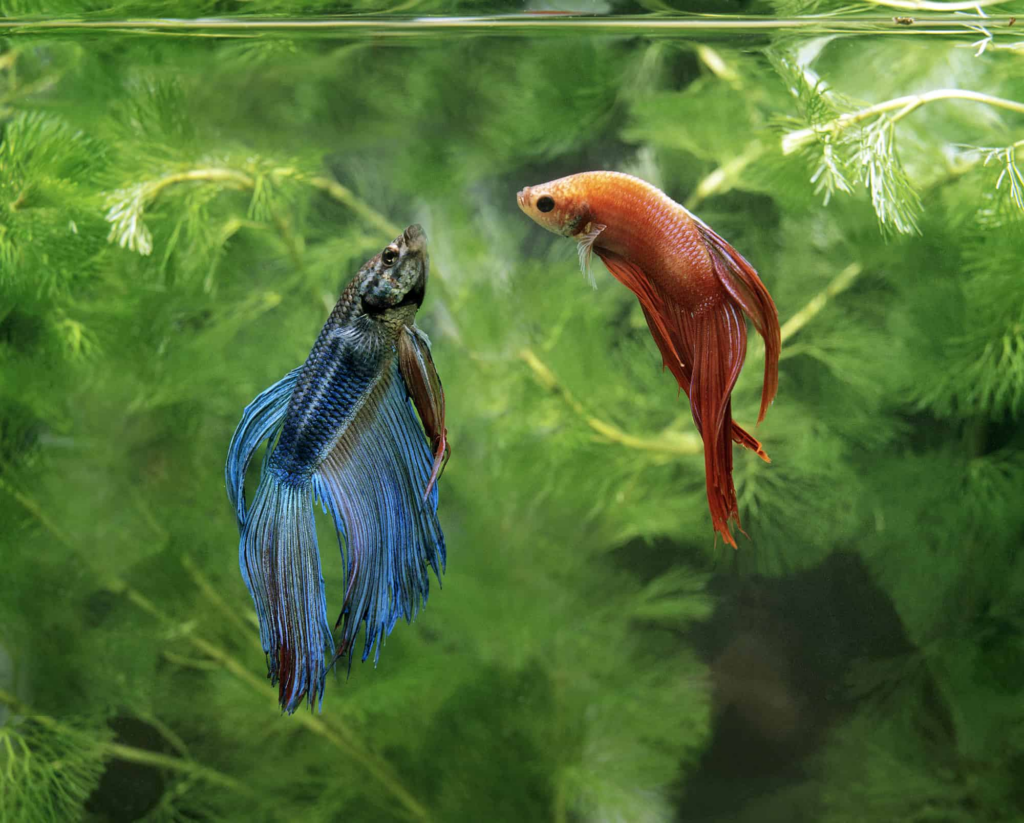Betta fish, also known as Siamese fighting fish, are beautiful and captivating aquatic creatures that have gained popularity among fish enthusiasts. While they are known for their vibrant colors and flowing fins, one common question many enthusiasts have is how many betta fish can live together peacefully in a single tank.

Understanding the Nature of Betta Fish
To understand how many betta fish can coexist in a tank, it’s essential to dive into their natural behavior and territorial instincts. Betta fish have an inherently aggressive nature, especially the males, which has led to their common name, “Siamese fighting fish.” In their natural habitat, male bettas would engage in fierce territorial battles to establish dominance.
While female bettas are generally less aggressive, they may still display territorial behavior when placed in a confined space. Therefore, it is crucial to consider their natural disposition when determining how many betta fish can live together.

Factors to Consider Before Introducing Multiple Betta Fish
Several factors play a role in determining the number of betta fish that can comfortably coexist in a single tank:
Tank Size and Space Requirements
The size of the tank is crucial in providing enough space and territory for each betta fish. A larger tank minimizes territorial disputes and allows each fish to establish its own territory. For multiple bettas, it is generally recommended to have a tank size of at least 10 gallons.
Proper Filtration and Water Quality
Maintaining excellent water quality is essential for the health and well-being of betta fish. Adequate filtration and regular water changes help remove toxins and maintain stable water parameters. Ensuring optimal water conditions can reduce stress and minimize aggression among bettas.
Compatibility of Betta Fish Species
When considering multiple betta fish in one tank, it is important to choose compatible species. While female bettas can coexist peacefully when properly introduced, care should be taken when considering male bettas together. Male bettas should never be housed together, as their aggressive nature will lead to fights and potential harm.
Gender Considerations
When it comes to female bettas, a good number to keep together is 4-6. Unlike males, female bettas can coexist peacefully in a community tank when provided with enough space and hiding spots. Having more females helps distribute aggression and prevents the dominant fish from targeting a single individual.

Creating a Suitable Environment for Multiple Betta Fish
Setting up a suitable environment is crucial to promote harmony among betta fish living together:
Tank Setup and Decoration Tips
When creating a tank for multiple bettas, it is essential to include plenty of hiding spots and territories. Live or artificial plants, caves, and driftwood can provide bettas with places to retreat and establish boundaries. These hiding spots help minimize stress and reduce the likelihood of aggression.
Maintaining Water Parameters
Bettas thrive in tropical freshwater environments. The ideal temperature for betta fish is around 78-80°F (25-27°C), and the pH level should be kept between 6.5 and 7.5. Regular monitoring of water parameters and appropriate adjustments are necessary to ensure the well-being of the fish.
Providing Hiding Spots and Territories
Each betta fish should have its own space and hiding spots to retreat to. This helps establish territories and reduces the likelihood of conflicts. Incorporating various structures and plants throughout the tank creates a visually appealing and well-divided space.

Introducing Multiple Betta Fish
Introducing betta fish requires careful planning and execution to ensure a smooth transition:
Step-by-Step Guide for Introducing Betta Fish
1. Prepare the tank: Set up the tank with appropriate hiding spots and decorations before introducing the bettas.
2. Observe the fish: Monitor the bettas’ behavior for a few days before introducing them to the tank. This helps identify any signs of aggression or stress that may require adjustments.
3. Gradual introduction: When introducing bettas, it is recommended to do so in small groups and gradually increase the number over time. This allows the fish to establish territories and become familiar with one another.
4. Monitor and address aggressive behavior: Pay close attention to any signs of aggression or territorial disputes among the bettas. If necessary, remove and isolate aggressive individuals to prevent injuries.
Signs of Compatibility or Conflict
It’s important to know how to identify signs of compatibility or conflict among betta fish:
Identifying Signs of Compatibility Between Betta Fish
Compatible bettas exhibit behaviors such as peaceful coexistence, minimal fin nipping, and no signs of aggression. They swim freely and display vibrant colors in a stress-free environment.
Recognizing Signs of Territorial Conflict
Signs of territorial conflicts include aggressive behavior, flaring fins, chasing, and biting. If bettas are constantly fighting or displaying signs of stress, it may be necessary to separate them to prevent injuries.
Preventing and Managing Potential Conflicts
Ensure that each betta has enough personal space and hiding spots to minimize conflicts. If aggression persists, consider redistributing the tank or providing additional territorial boundaries to reduce stress levels.

Managing a Community Tank with Betta Fish
Creating a harmonious community tank with betta fish involves careful choices of tankmates:
Suitable Tankmates for Betta Fish
Compatible tankmates for bettas include peaceful community fish, such as neon tetras, corydoras catfish, or livebearers like guppies. Avoid adding fin-nipping or aggressive species that may provoke bettas.
Tips for Maintaining a Harmonious Community Tank
Regularly monitor the tank and observe the behavior of all tank inhabitants. Ensure there is enough food for all fish and maintain appropriate water parameters for the well-being of the community.
Common Mistakes to Avoid
When keeping multiple betta fish together, avoid these common mistakes:
Overcrowding the Tank
Overcrowding can lead to stress, competition for resources, and increased aggression. Maintain a proper fish-to-space ratio to ensure the overall well-being of the tank inhabitants.
Neglecting Water Quality and Maintenance
Poor water quality leads to stress and weakened immune systems, making the fish more susceptible to diseases. Regular water changes and proper filtration are vital for the health of all fish in the tank.
Choosing Incompatible Tankmates
Selecting incompatible tankmates can disrupt the harmony of the tank and result in aggressive or territorial behavior from the bettas. Research and choose suitable tankmates that won’t cause conflicts.
Betta Harmony: Creating a Serene Sorority Tank
Can two betta fish live together? In a fish tank housing two male betta fish, creating a betta sorority tank can be a captivating sight. The vibrant colors of male bettas add flair to the aquatic landscape. However, ensuring suitable tank mates is crucial. Introducing other fish that share similar temperaments and space requirements can foster a harmonious aquatic community. With the volume up, witness the serene dance of male bettas alongside their tank mates, creating a mesmerizing aquatic tableau.

Dynamic Aquatic Duos: Male Bettas and Tank Mates
While male betta fish are stunning on their own, the dynamics shift when they share the same tank. It’s essential to consider suitable tank mates to maintain peace. Introducing other betta fish or compatible species can enhance the fish tank’s ecosystem.
Observing the interactions between two male bettas and their companions offers insights into their social behaviors. With the volume up, immerse yourself in the tranquility of a well-balanced aquatic environment.
Conclusion
When it comes to how many betta fish can live together, it is essential to consider their nature, tank size, water parameters, and compatibility. Female betta fish can generally coexist peacefully when provided with adequate space and hiding spots.
By understanding their unique characteristics and following proper introductions and maintenance, it is possible to create a harmonious and visually stunning community tank with multiple betta fish.










